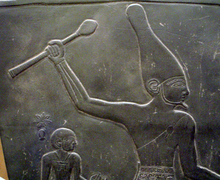This is an old revision of this page, as edited by Thanatosimii (talk | contribs) at 03:33, 16 March 2007 (revert removal of source not violating said guidline). The present address (URL) is a permanent link to this revision, which may differ significantly from the current revision.
Revision as of 03:33, 16 March 2007 by Thanatosimii (talk | contribs) (revert removal of source not violating said guidline)(diff) ← Previous revision | Latest revision (diff) | Newer revision → (diff)| Narmer | ||||||
|---|---|---|---|---|---|---|
 | ||||||
| Pharaoh | ||||||
| Predecessor | Scorpion? | |||||
| Successor | Menes? | |||||
Royal titulary
| ||||||
| Consort | Neithhotep A | |||||
| Burial | Tomb B17/B18, Umm el-Qa'ab, Abydos | |||||
| Dynasty | 1st Dynasty | |||||
Narmer was an Egyptian Pharaoh who ruled in the 31st century BC. Thought to be the successor to the predynastic Scorpion, he is considered by some to be the founder of the First dynasty, and therefore the first king of all Egypt. There is a growing consensus that Scorpion and Narmer are identical, but no identification with any early king can yet be definitively proven. Narmer's name is represented phonetically by the hieroglyphic sign for a catfish (n'r) and that of a chisel (mr). Modern variants of his name include "Narmeru" or "Merunar", but convention uses "Narmer".

The famous Narmer Palette, discovered in 1898 in Hierakonpolis, shows Narmer displaying the insignia of both Upper and Lower Egypt, giving rise to the theory that he unified the two kingdoms. Traditionally, Menes is credited with that unification, and he is listed as being the first king in Manetho's list of kings, so this find has caused some controversy.
Some Egyptologists hold that Menes and Narmer are the same person; some hold that Menes is the same person as Hor-Aha and that he inherited an already-unified Egypt from Narmer; others hold that Narmer began the process of unification but either did not succeed or succeeded only partially, leaving it to Menes to complete. Arguments have been made that Narmer is Menes because of his appearance on several ostraca in conjunction with the gameboard hieroglyph, Mn, which appears to be a contemporary record to the otherwise mythical king. However, there are inconsistencies within every ostracon which mentions Menes, precluding any definitive proof to his identity.
Another equally plausible theory is that Narmer was an immediate successor to the king who did manage to unify Egypt (perhaps the King Scorpion whose name was found on a macehead also discovered in Hierakonpolis), and adopted symbols of unification that had already been in use for perhaps a generation. The king lists recently found in Den's and Qa'a's tombs both list Narmer as the founder of their dynasty.
His wife is thought to have been Neithhotep A, a princess of northern Egypt. Inscriptions bearing her name were found in tombs belonging to Narmer's immediate successors Hor-Aha and Djer, implying either that she was the mother or wife of Hor-Aha.
His tomb is thought to have been comprised of two joined chambers (B17 and B18) found in the Umm el-Qa'ab region of Abydos.
During the summer of 1994, excavators from the Nahal Tillah expedition in southern Israel discovered an incised ceramic shard with the serekh sign of Narmer, the same individual whose ceremonial slate palette was found by James E. Quibell in Upper Egypt. The inscription was found on a large circular platform, possibly the foundations of a storage silo on the Halif Terrace. Dated to ca. 3000 BC, mineralogical studies of the shard conclude that it is a fragment of a wine jar which was imported from the Nile valley to Israel some 5000 years ago.
See also
External links
References
- Dodson, Aidan. Hilton, Dyan. 2004. The Complete Royal Families of Ancient Egypt, Thames & Hudson
- Kinnaer, Jacques. What is Really Known About the Narmer Palette?, KMT: A Modern Journal of Ancient Egypt, Spring 2004.
- Narmer: Titulary
- Shaw, Ian. The Oxford History of Ancient Egypt. p.196. Oxford University Press, 2000.
- Gardiner, Alan. Egypt of the Pharaohs. p. 405. Oxford University Press, 1961
- ibid.
- ibid.